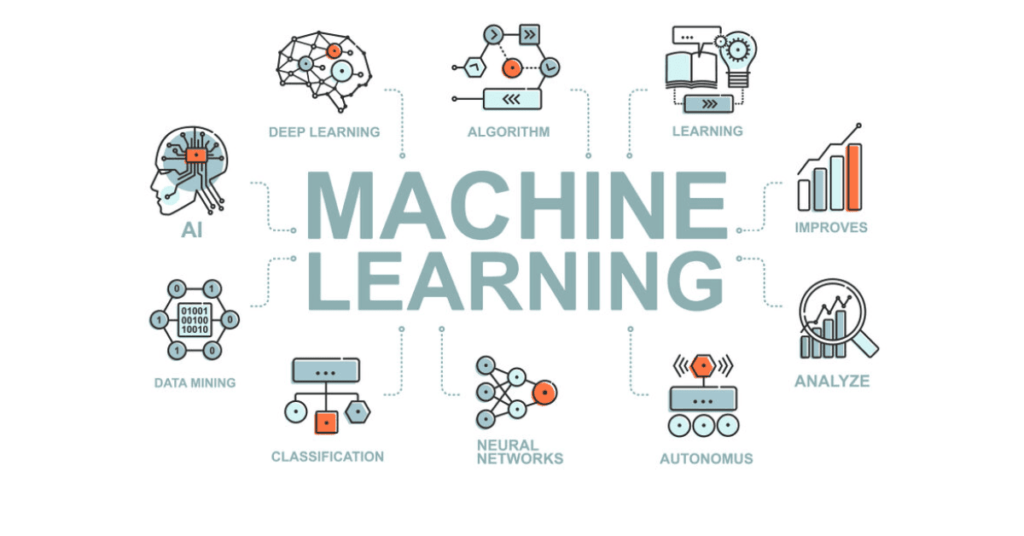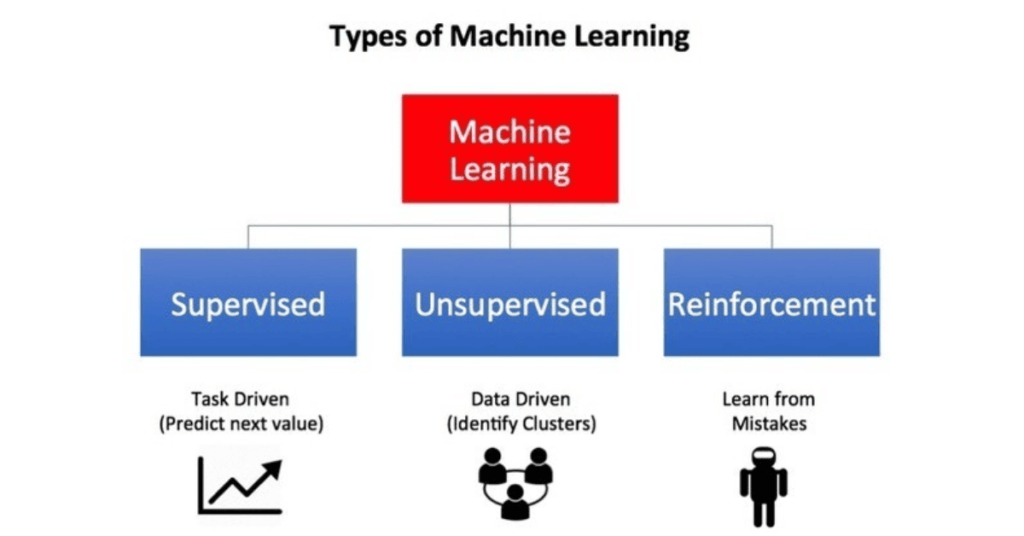Machine learning (ML) is a part of artificial intelligence (AI) that teaches computers to learn from data and make decisions without being specifically programmed for every task . It’s a powerful technology that helps make everyday tools smarter from recommending movies on Netflix to guiding self-driving cars. In this article, we’ll break down the basics of machine learning, how it works and where it’s used .
Machine Learning
Machine Learning is all about teaching a computer to recognize patterns in data and make predictions based on those patterns. Unlike traditional programming , where a programmer writes specific instructions for the computer, machine learning allows the computer to learn and improve on its own by analyzing data
For example imagine a system that helps predict the weather. By feeding it historical weather data (like temperature, humidity and wind speed) the system can learn how these factors influence future weather and eventually make predictions for tomorrow .

Types of Machine Learning
Machine learning can be divided into three main types :

- Supervised Learning:
This is the most common form of machine learning. In supervised learning, the algorithm is trained using a dataset that includes both the input (like an image or a piece of text) and the correct output (like a label that says whether the image is of a cat or a dog) . The model learns to connect the inputs to the right outputs, and later, it can predict the output for new inputs. A good example is spam email filters that learn to classify emails as spam or not based on labeled example. - Unsupervised Learning:
In unsupervised learning, the data used to train the model doesn’t come with labels. Instead, the algorithm tries to find hidden patterns or structures in the data. For example it can group similar data points together, like grouping customers with similar buying behaviors in marketing. It’s used in tasks like clustering or organizing data into categories without prior knowledge of what those categories should be. - Reinforcement Learning:
This type of learning is inspired by how humans and animals learn through trial and error. In reinforcement learning, an agent (like a robot or a game-playing AI) learns by interacting with its environment and receiving feedback in the form of rewards or penalties. Over time the agent improves its actions to maximize rewards. For example a robot might learn to walk or play a video game through repeated attempts and feedback.
Common Machine Learning Algorithms
Machine learning uses various algorithms to train models and solve problems. Here are a few of the most commonly used ones :
- Linear Regression: This algorithm is used when predicting continuous values, like predicting house prices or sales revenue.
- Decision Trees: Decision trees help make decisions by splitting data into smaller chunks based on certain criteria. It’s a simple and interpretable method used in tasks like classification (sorting data into categories) and regression.
- K-Means Clustering: This algorithm is great for grouping data into clusters based on similarities. It’s commonly used in customer segmentation or organizing large datasets .
- Neural Networks: Inspired by the human brain, neural networks are made up of layers of nodes (or “neurons”). These networks are especially powerful for tasks like image recognition, voice recognition and natural language processing .
Real-World Applications of Machine Learning
Machine learning is not just a buzzword it’s used in many fields to make systems smarter. Let’s look at a few areas where it’s making a big impact :
- Healthcare:
ML is being used to analyze medical data, detect diseases early, and create personalized treatment plans. For example, algorithms can analyze medical images like X-rays or MRIs to help doctors identify conditions such as cancer. It’s also used to predict patient outcomes and suggest the best treatments based on individual data . - Finance:
In the finance industry, machine learning helps with things like fraud detection, algorithmic trading, and credit scoring. For instance , banks use ML to detect unusual patterns in transactions that might indicate fraudulent activity. Trading algorithms can analyze market data and make buy/sell decisions in real time. - Retail:
Online retailers like Amazn use machine learning to recommend products to customers based on their browsing and purchasing history. ML is also used in inventory management to predict demand and ensure that stores have enough stock of popular products. - Self-Driving Cars:
Machine learning plays a key role in the development of self-driving cars. These vehicles use sensors and cameras to gather data about their surroundings. Machine learnng algorithms help the car understand its environment, make decisions about how to navigate and ensure it reacts safely to obstacles and changing road conditions. - Natural Language Processing (NLP):
NLP is a branch of machine learning that helps computers understand and process human language. This technology is behind voice assistants like Siri and Alexa, as well as tools for language translation and text analysis. It allows machines to interpret commands, answer questions or even hold conversations with users.
Challenges and the Future of Machine Learning
Although machine learning is an exciting field, there are still some challenges. One major issue is ensuring that machine learning models are fair and unbiased, especially when making decisions that affect people’s lives, like in hiring or law enforcement. Another challenge is making sure that ML models are explainable, so we can understand how they make decisions.
Looking ahead, the future of machine learning is full of possibilities. As more data becomes available and computers become more powerful, ML models will continue to improve and tackle more complex tasks . Advances in explainable AI and automated machine learning (AutoML) will make it easier for businesses and individuals to use ML even without deep technical expertise.
Machine learning is transforming many aspects of our world, from healthcare to entertainment to self-driving cars. By teaching computers to learn from data, we can create smarter systems that improve over time. While there are still challenges to overcome, the potential for machine learningg to drive innovation is immense. Whether you’re just starting to learn about it or already working with it, understanding the basics of machine learning can open up new opportunities in technology and beyond .
Frequently Asked Questions(FAQs)
What is machine learning?
Machine learning is a branch of artificial intelligence that enables computers to learn from data and make predictions or decisions without being explicitly programmed. it identifies patterns in data and uses them to make informed decisions or predictions on new data.
What are the different types of machine learning?
The three main types of machine learning are :
Supervised Learning: The model is trained on labeled data (input-output pairs) and learns to predict the output for new inputs.
Unsupervised Learning: The model works with data that has no labels and tries to find patterns or structures in the data.
Reinforcement Learning: The model learns through trial and error by interacting with its environment and receiving feedback in the form of rewards or penalties.What is an example of supervised learning?
A common example of supervised learning is email spam detection. The model is trained with a dataset of labeled emails (spam or not) and learns to classify new emails into the correct category.
How does unsupervised learning work?
In unsupervised learning, the algorithm is given data without any labels. It tries to find hidden patterns or groupings within the data. For example it can cluster customers based on their purchasing habits, even if no labels (like high spender or low spender) are provided.
What are some common machine learning algorithms?
Some popular machine learning algorithms include :
Linear Regression: Used for predicting continuous values like house prices.
Decision Trees: A model that makes decisions by splitting data into branches based on specific features.
K-Means Clustering: Used to group data into clusters based on similarity.
Neural Networks: Inspired by the human brain, these are powerful models used for tasks like image and speech recognition.Where is machine learning used in real life?
Machine learning is used in various fields, including :
Healthcare: For early disease detection, personalized treatment and predicting patient outcomes.
Finance: To detect fraud, make investment decisions, and assess credit risk.
Retail: For product recommendations and inventory management.
Self-Driving Cars: To help vehicles understand their environment and make driving decisions.
Natural Language Processing: To process and understand human language, powering virtual assistants and language translation tools.What challenges does machine learning face?
Machine learning faces several challenges, including :
Bias: ML models can unintentionally reflect biases present in the data, leading to unfair decisions.
Interpretability: Some ML models, like neural networks, are complex and hard to understand, making it difficult to explain how they make decisions.
Data Quality: The performance of machine learning models heavily depends on the quality and quantity of data used for training.What does the future of machine learning look like?
The future of machine learning is promising, with advancements in areas like explainable AI, automated machine learning (AutoML) and improved model accuracy. As more data becomes available and computing power increases, ML will continue to evolve, unlocking new opportunities in technology, healthcare, finance and other industries.
How can I start learning about machine learning?
To start learning about machine learning, it’s helpful to understand basic concepts in mathematics, such as statistics, linear algebra and calculus. Many online resources, courses, and tutorials are available for beginners, including platforms like Coursera, edX and Udacity. Hands-on practice through coding challenges and projects can also help you gain experience.









